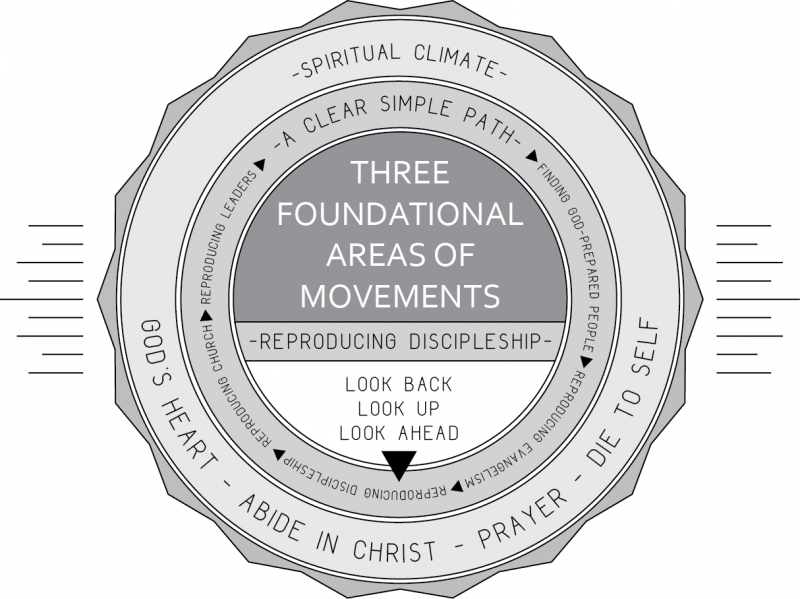THREE FOUNDATIONAL AREAS OF MOVEMENTS

|
In any multi-generational movement in which disciples and churches are multiplying beyond the fourth generation in multiple contexts, a set of common characteristics will be in place. Church planting movement (CPM) and disciple making movement (DMM) practitioners present a variety of frameworks to summarize those critical elements. Many of those frameworks detail 10-15 elements in movements. |
 All of these elements can be summed up in three essential areas. Without any of these areas in place a CPM/DMM will not emerge or remain sustained. The purpose of this article is not to review or debate the various frameworks (or ways of detailing movements) but to summarize what the three most critical areas are.
All of these elements can be summed up in three essential areas. Without any of these areas in place a CPM/DMM will not emerge or remain sustained. The purpose of this article is not to review or debate the various frameworks (or ways of detailing movements) but to summarize what the three most critical areas are.
If a framework is complete its elements can be summarized in three basic areas: 1) spiritual climate, 2) a clear, simple path and 3) a reproducing discipleship process.
SPIRITUAL CLIMATE FOR HEALTHY MOVEMENTS
One common example is the Heart and Four Fields framework that was highlighted in the article “CPM Essentials on a Napkin” in the July-August 2013 issue of Mission Frontiers. In this framework around twelve major factors summarize how movements start and progress. This is just one way of looking at the same elements that other practitioner summarize in their frameworks.
All healthy CPM frameworks highlight elements that are not simply methodological but also spiritual. For instance the Heart and Four fields framework highlights several major areas:
· God’s heart (His vision) has so gripped the hearts of believers that they are sacrificially committed to seeing multi-generational churches start in every major segment of their
society because they believe this is the way to reach the vision.
· These disciples bear fruit because they abide deeply in Christ and Christ’s Word abides in them (John 15). They want to be the type of people God uses to launch movements.
· They cry out to God in fervent prayer for Him to fulfill what’s on His heart and are unwilling to turn loose of heaven’s throne.
· And they die to self and persevere in difficult times to see God’s heart fulfilled. They are completely surrendered to the Spirit.
These elements highlight that a spiritual climate is in place in which appropriate biblical methodologies can bear fruit. Without the spiritual climate and surrender, methods become mechanistic and bear little or no lasting fruit. The proper spiritual climate must be addressed first, and frankly, it is the most difficult of the three areas to instill. That is because it involves complete surrender and reliance upon the Holy Spirit.
When training believers, this is always the first and chief area I look to in trying to develop them into disciples who pursue the Father’s heart.
All of us have a natural tendency to overemphasize one of the three major areas. There are dangers inherent in each tendency. Those who emphasize spiritual climate alone sometimes feel it “unspiritual” when others put emphasis on CPM/DMM methodologies. Those who emphasize the spiritual climate to the detriment of the other two areas will find that they will not put into the hands of disciples practical handles to implement the vision.
This leads highlights the second critical element.
A CLEAR, SIMPLE PATH TOWARDS HEALTHY MOVEMENTS
Proverbs clarifies the need for a clear path to attain a vision:
Hope deferred makes the heart sick,
but a desire fulfilled is a tree of life. (Proverbs 13:12, ESV)
When a vision of Father’s heart grips a group of people but they can see no clear path on how to fulfill it, their hearts will become sick. When we point them to a clear path forward, it produces life in them.
Every CPM emerges because it has found a way to move forward practically toward the vision in the midst of the spiritual climate. Believers must have a clear path that they can walk through the major elements of a healthy and sustained movement. They know what to do when their disciples say “yes” at each stage. Their path is also simple enough that a new disciple can reproduce it. In this manner a movement can multiply generation by generation.
In the Heart and Four Fields framework, for example, five elements of this path are highlighted:
1. How to find God-prepared people (saved and lost) and how to start the spiritual process with them (entry)
2. How to evangelize the lost in a reproducing way
3. How to disciple them for the short term and the long term in a reproducing manner
4. How to form reproducing churches
5. How to raise up and develop leaders in a reproducing manner.
In each of these “fields” content is clear and simple, and naturally leads to the next field. It is simple enough that a third or fourth generation believer can use it and pass it on.
What is essential is that this path leads to the essential elements that make for healthy movements, not lopsided ones. The methodological path forward must be clear and simple enough that disciples entering this movement know how to walk through these stages of a movement. These basic areas of methodology can be summarized in other ways, but for a movement to emerge believers must know the plan and be able to walk out the plan. Without such a plan with clear content and clear methods, the vision never reaches fruition.
There are inherent dangers in overemphasizing the path over the other two areas. Believers walking out the path can become burnt out if the spiritual elements of abiding in Christ and surrender are not in place. In addition, the plan can remain theoretical if the third critical area is missing.
REPRODUCING DISCIPLESHIP PROCESS
Many practitioners have a clear plan but the way they implement it will not reproduce because they lack a reproducing discipleship process. It is not uncommon to observe CPM/DMM practitioners training believers in the methodology in a sterile, lecture format – devoid of spiritual encounters with God and devoid of a reproducing format for discipleship.
Every CPM has a reproducing process of discipleship that equips believers to gain confidence and competence to implement the path and attain the vision. It is a process that encourages and coaches the believers forward. It is a process that sets expectations high and catches disciples in the safety net of love when they fall down.
Every movement needs a weekly or bi-weekly reproducing discipling encounter to help believers fulfill the vision. A PATH without a PROCESS will make very little PROGRESS. The process is the manner of meeting with disciples—the essential elements of what makes a discipleship meeting.
Every movement that I know of uses a regular long-term discipling process to help believers implement this path. Virtually every CPM system (e.g. T4T, DBS, DMM) includes something like a three-thirds discipleship process. The exact elements in each section may vary but the overall three-thirds elements are achieved:
1. In the first third of the discipleship meeting believers take time to look back and evaluate how they’ve done lovingly obeying the Father.
2. In the second third they take time to look up to ask the Father what He has for them that week in the Word. They seek to encounter God.
3. In the last third they take time to look ahead to ask how can we then implement this with their disciples and in their evangelism the following week.
This discipling process creates a spiritual culture of stirring one another up to love and good deeds:
And let us consider how to stir up one another to love and good works, not neglecting to meet together, as is the habit of some, but encouraging one another, and all the more as you see the Day drawing near. (Hebrews 10:24-25, ESV)
In the Heart and Four Fields framework, it is depicted by the three-thirds discipleship process of field three.
A process is in place to equip believers to implement the plan much like Paul describes:
And he gave the apostles, the prophets, the evangelists, the shepherds and teachers, to equip the saints for the work of ministry, for building up the body of Christ, until we all attain to the unity of the faith and of the knowledge of the Son of God, to mature manhood, to the measure of the stature of the fullness of Christ…. (Eph. 4:11-13, ESV)
 As with the other two areas, we can overemphasize this area in an unhealthy way. Practitioners may implement the three-thirds process in a mechanistic way, putting faith in the elements of the three thirds rather than the encounter with God. Emphasizing the three thirds over hearing and responding to the Spirit in each discipleship meeting is a recipe for disaster.
As with the other two areas, we can overemphasize this area in an unhealthy way. Practitioners may implement the three-thirds process in a mechanistic way, putting faith in the elements of the three thirds rather than the encounter with God. Emphasizing the three thirds over hearing and responding to the Spirit in each discipleship meeting is a recipe for disaster.
In addition, emphasizing the three thirds but giving the believers no clear path or no clear content for how to begin discipling their friends will end in frustration for everyone. The content must be clear as well as the process.
HOLD ALL THREE IN BALANCE
It is not easy, but CPMs emerge when practitioners learn how to hold all three areas in balance: spiritual climate, clear simple path and reproducing process. Movements of God are a spiritual work, and we must learn to follow the Spirit’s leading in how to balance the three areas. It is helpful to periodically evaluate the climate, the path and the process at key junctures in our ministries. At times we will find that we must overemphasize one or the other to bring a movement back into balance. But without frequent check-ups, this overemphasis can lead to pushing the movement too far into another direction.
By understanding the three areas, however, we can encourage movements to emerge and continue as healthy, spiritual movements for many years to come. These areas must remain balanced at each generation of the movement. It is not uncommon for them to be balanced at the first generation but to become unbalanced further downstream.
As you look at your ministry, is each of these areas in place at each generation? What needs the most emphasis at this point?









comments